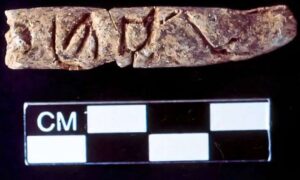A few years ago, archaeologists working in Hohle Fels Cave in southwestern Germany unearthed some mysterious ice-age objects. The team found 13 pieces of carved mammoth ivory that fit together to form what they described as a “perforated baton, with four holes containing precisely carved spiral grooves.”
A wand, an instrument, or perhaps a totem?
Depending on the viewer, the artifact looks like an instrument, a wand, or perhaps something ritualistic, a decorative symbol for some long-forgotten religion. Scientists discovered other similar artifacts at another site in Germany, but their purpose remained unclear.
Now, archaeologists Nicholas Conard (from the University of Tubingen in Germany) and Veerle Rots (from the University of Liege in Belgium) believe they’ve solved the mystery.
In a new paper, Conard and Rots argue that the 35,000-year-old ivory baton is a tool for making rope. Researchers were fairly sure that Paleolithic people used rope or twine, but the evidence was limited to depictions in art and a few impressions in clay. While evidence that ice-age people used rope was limited, there was no evidence illuminating how they manufactured it. Therefore the paper’s conclusion is a major breakthrough.
The grooved holes were the key.

Perforated ivory baton from Hohle Fels Cave, Germany. Photo: H. Jensen, University of Tubingen
Grooved holes still lined with fibers
“We suspected that the holes with spiral grooves were made to have something fed through them, which led us to hypothesize that the artifact may have served to align fibers to make rope or twine. While twine can be made by hand without tools, by pulling and twisting plant fibers together, we tested whether or not the perforated baton from Hohle Fels could have been used to align, twist, and combine fibers to make rope,” the paper explains.
Microscopic examination revealed fiber remnants around the grooves. Conard and Rots compared these fibers with sediment samples from around the artifact to rule out simple contamination from the environment. They found that the soil contained few plant fibers.
As a final test, Conard and Rots made a perforated baton of their own and tested it. Using the grooved holes they found that they could twist thick cords of up to four strands quickly and efficiently. They tested a few materials believed to be common during the period including deer sinew, flax, hemp, and others. They found cattail and willow fibers produced the best results.
“We are now able to demonstrate one way people of the early Upper Paleolithic manufactured rope. This work contributes to our understanding of the evolution of technology, cooperative work, and Paleolithic social organization,” the authors conclude.






